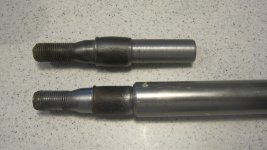I want to permanently attach a solid, threaded end to a piece of tubing, as shown. The tubing is DOM 15/16" OD and 11/16" ID.
I will TIG weld the solid end in place...but is it a good idea to also drill a 5/16" hole through the pieces and press in a cross pin? I would then weld the pin in place.
This piece will see almost all loads in tension - meaning the tendency will be to pull the solid end out of the tube.
I will TIG weld the solid end in place...but is it a good idea to also drill a 5/16" hole through the pieces and press in a cross pin? I would then weld the pin in place.
This piece will see almost all loads in tension - meaning the tendency will be to pull the solid end out of the tube.


